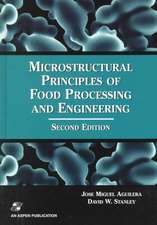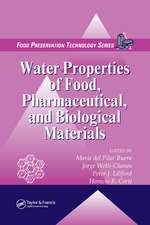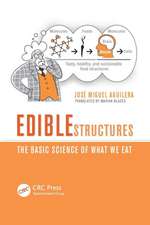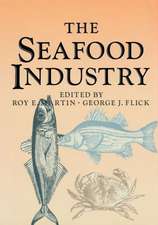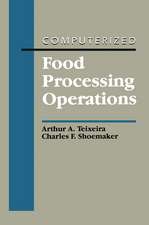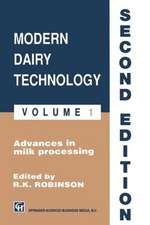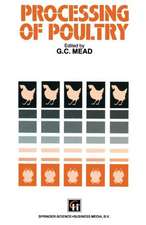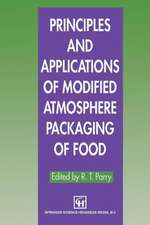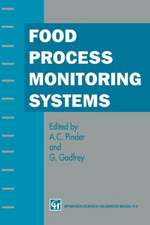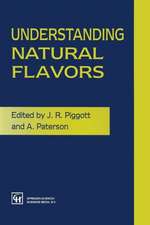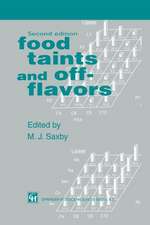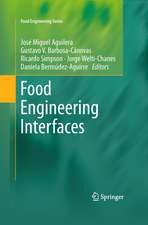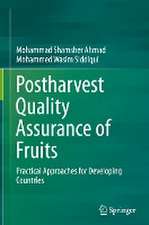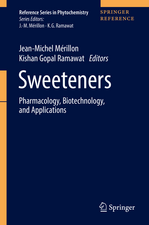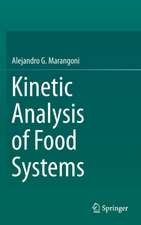Food Materials Science: Principles and Practice: Food Engineering Series
Editat de José Miguel Aguilera, Peter J. Lillforden Limba Engleză Hardback – 6 dec 2007
The creation of added value from raw food materials is a legitimate aspiration of the modern food industry. Adding value to foods requires knowledge of what the consumer wants and creating products that satisfy the demand. Quality, convenience and safety are the major drivers of the modern food industry.
Food manufacture is about producing billions of units of standardized products which must be cheap, nutritious, safe and appealing to the consumer’s taste. Food products are complex multicomponent and structured edible materials that nevertheless must comply with the laws of physics and fundamentals of engineering sciences. In the last 20 years the design of food products with specific functionalities has advanced significantly by the application of scientific knowledge from disciplines such as polymer physics, colloidal and mesoscopic physics, materials science and new imaging and probing techniques borrowed from chemistry, biology and medicine. Our knowledge of the relationship between microstructure, processing, and macroscopic properties continues to increase as the science of food materials advances at a fast pace.
This book is intended to those interested in viewing food technology as a way to preserve, transform and create structures in foods and the related materials science aspects of it. It attempts to present a unified vision of what today is considered to be food materials science and some derived applications. The book may be used as a text in a course in food materials science at the senior or graduate level or as a supplement text in an advanced food technology course. It will also serve as a reference book for professionals in the food industry.
| Toate formatele și edițiile | Preț | Express |
|---|---|---|
| Paperback (1) | 1184.61 lei 6-8 săpt. | |
| Springer – 3 noi 2014 | 1184.61 lei 6-8 săpt. | |
| Hardback (1) | 1188.39 lei 6-8 săpt. | |
| Springer – 6 dec 2007 | 1188.39 lei 6-8 săpt. |
Din seria Food Engineering Series
- 18%
 Preț: 1333.98 lei
Preț: 1333.98 lei - 18%
 Preț: 942.87 lei
Preț: 942.87 lei - 15%
 Preț: 622.91 lei
Preț: 622.91 lei - 18%
 Preț: 925.12 lei
Preț: 925.12 lei - 18%
 Preț: 1343.83 lei
Preț: 1343.83 lei - 15%
 Preț: 688.48 lei
Preț: 688.48 lei - 18%
 Preț: 915.13 lei
Preț: 915.13 lei - 18%
 Preț: 1175.22 lei
Preț: 1175.22 lei - 18%
 Preț: 929.24 lei
Preț: 929.24 lei - 18%
 Preț: 1773.30 lei
Preț: 1773.30 lei - 18%
 Preț: 917.09 lei
Preț: 917.09 lei - 18%
 Preț: 931.03 lei
Preț: 931.03 lei - 15%
 Preț: 622.42 lei
Preț: 622.42 lei - 18%
 Preț: 1482.09 lei
Preț: 1482.09 lei - 15%
 Preț: 622.91 lei
Preț: 622.91 lei - 18%
 Preț: 1184.61 lei
Preț: 1184.61 lei -
 Preț: 370.26 lei
Preț: 370.26 lei - 18%
 Preț: 1187.02 lei
Preț: 1187.02 lei - 23%
 Preț: 926.54 lei
Preț: 926.54 lei - 18%
 Preț: 924.82 lei
Preț: 924.82 lei - 15%
 Preț: 628.10 lei
Preț: 628.10 lei - 15%
 Preț: 620.07 lei
Preț: 620.07 lei - 15%
 Preț: 618.50 lei
Preț: 618.50 lei - 18%
 Preț: 935.27 lei
Preț: 935.27 lei - 18%
 Preț: 1021.40 lei
Preț: 1021.40 lei - 18%
 Preț: 908.31 lei
Preț: 908.31 lei - 18%
 Preț: 924.09 lei
Preț: 924.09 lei - 18%
 Preț: 1178.09 lei
Preț: 1178.09 lei - 18%
 Preț: 924.39 lei
Preț: 924.39 lei - 15%
 Preț: 621.34 lei
Preț: 621.34 lei - 15%
 Preț: 565.21 lei
Preț: 565.21 lei -
 Preț: 470.62 lei
Preț: 470.62 lei - 15%
 Preț: 614.24 lei
Preț: 614.24 lei - 15%
 Preț: 617.72 lei
Preț: 617.72 lei - 18%
 Preț: 1354.89 lei
Preț: 1354.89 lei - 18%
 Preț: 2027.29 lei
Preț: 2027.29 lei - 15%
 Preț: 631.40 lei
Preț: 631.40 lei -
 Preț: 383.96 lei
Preț: 383.96 lei - 15%
 Preț: 620.07 lei
Preț: 620.07 lei - 18%
 Preț: 920.13 lei
Preț: 920.13 lei - 18%
 Preț: 914.66 lei
Preț: 914.66 lei
Preț: 1188.39 lei
Preț vechi: 1449.25 lei
-18%
Puncte Express: 1783
Preț estimativ în valută:
210.32€ • 245.80$ • 182.60£
210.32€ • 245.80$ • 182.60£
Carte tipărită la comandă
Livrare economică 20 februarie-06 martie
Preluare comenzi: 021 569.72.76
Specificații
ISBN-13: 9780387719467
ISBN-10: 0387719466
Pagini: 616
Ilustrații: X, 616 p.
Dimensiuni: 155 x 235 x 34 mm
Greutate: 0.98 kg
Ediția:2008
Editura: Springer
Colecția Springer
Seria Food Engineering Series
Locul publicării:New York, NY, United States
ISBN-10: 0387719466
Pagini: 616
Ilustrații: X, 616 p.
Dimensiuni: 155 x 235 x 34 mm
Greutate: 0.98 kg
Ediția:2008
Editura: Springer
Colecția Springer
Seria Food Engineering Series
Locul publicării:New York, NY, United States
Public țintă
Professional/practitionerCuprins
Fundamentals.- Why Food Materials Science?.- The Composite Structure of Biological Tissue Used for Food.- Food Polymers.- The Crystalline State.- The Glassy State.- Rubber Elasticity and Wheat Gluten Proteins.- State Diagrams of Food Materials.- Nanotechnology in Food Materials Research.- Assembly of Structures in Foods.- Solid Food Foams.- Probing Food Structure.- Structuring Operations.- Structure–Property Relationships in Foods.- Structuring Water by Gelation.- Bubble-Containing Foods.- Emulsions: Principles and Preparation.- Processing of Food Powders.- Fat Crystal Networks.- Extrusion.- Polyphasic Food Systems.- Structuring Dairy Products by Means of Processing and Matrix Design.- Structured Cereal Products.- Structured Meat Products.- Structured Chocolate Products.- Edible Moisture Barriers for Food Product Stabilization.- Encapsulation of Bioactives.
Textul de pe ultima copertă
Food Materials Science provides the science behind structuring processes for foods and applications in food product design. The first in its field, the book is an invaluable reference.
The creation of added value from raw food materials is a legitimate aspiration of the modern food industry. Adding value to foods requires knowledge of what the consumer wants and creating products that satisfy the demand. Quality, convenience and safety are the major drivers of the modern food industry.
Food manufacture is about producing billions of units of standardized products which must be cheap, nutritious, safe and appealing to the consumer’s taste. Food products are complex multicomponent and structured edible materials that nevertheless must comply with the laws of physics and fundamentals of engineering sciences. In the last 20 years the design of food products with specific functionalities has advanced significantly by the application of scientific knowledge from disciplines such as polymer physics, colloidal and mesoscopic physics, materials science and new imaging and probing techniques borrowed from chemistry, biology and medicine. Our knowledge of the relationship between microstructure, processing, and macroscopic properties continues to increase as the science of food materials advances at a fast pace.
This book is intended to those interested in viewing food technology as a way to preserve, transform and create structures in foods and the related materials science aspects of it. It attempts to present a unified vision of what today is considered to be food materials science and some derived applications. The book may be used as a text in a course in food materials science at the senior or graduate level or as a supplement text in an advanced food technology course. It will also serve as a reference book for professionals in the food industry.
About theEditors
José Miguel Aguilera, is a professor in the Department of Chemical Engineering and Bioprocesses at the Universidad Católica de Chile, Santiago, Chile
Peter J. Lillford, is a professor in the Department of Biology at the University of York, Heslington, York, UK
The creation of added value from raw food materials is a legitimate aspiration of the modern food industry. Adding value to foods requires knowledge of what the consumer wants and creating products that satisfy the demand. Quality, convenience and safety are the major drivers of the modern food industry.
Food manufacture is about producing billions of units of standardized products which must be cheap, nutritious, safe and appealing to the consumer’s taste. Food products are complex multicomponent and structured edible materials that nevertheless must comply with the laws of physics and fundamentals of engineering sciences. In the last 20 years the design of food products with specific functionalities has advanced significantly by the application of scientific knowledge from disciplines such as polymer physics, colloidal and mesoscopic physics, materials science and new imaging and probing techniques borrowed from chemistry, biology and medicine. Our knowledge of the relationship between microstructure, processing, and macroscopic properties continues to increase as the science of food materials advances at a fast pace.
This book is intended to those interested in viewing food technology as a way to preserve, transform and create structures in foods and the related materials science aspects of it. It attempts to present a unified vision of what today is considered to be food materials science and some derived applications. The book may be used as a text in a course in food materials science at the senior or graduate level or as a supplement text in an advanced food technology course. It will also serve as a reference book for professionals in the food industry.
About theEditors
José Miguel Aguilera, is a professor in the Department of Chemical Engineering and Bioprocesses at the Universidad Católica de Chile, Santiago, Chile
Peter J. Lillford, is a professor in the Department of Biology at the University of York, Heslington, York, UK
Caracteristici
Great as a text in a course in food materials science at the senior or graduate level or as a supplemental text in an advanced food technology course Will serve as a reference book for professionals in the food industry

